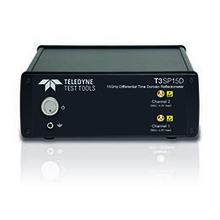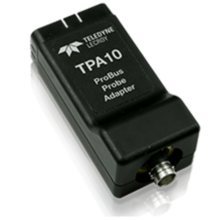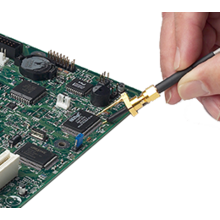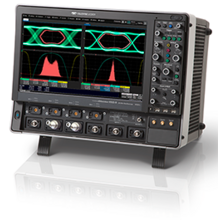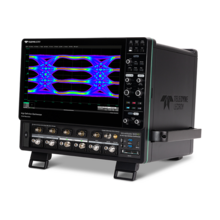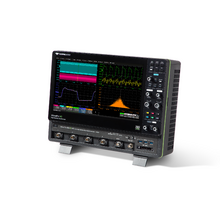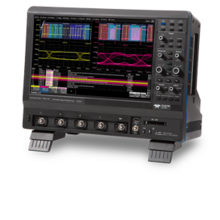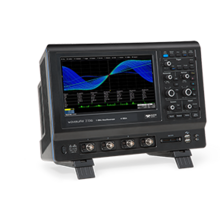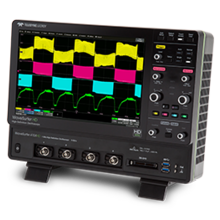Products
Displaying 721 - 732 of 835
True Differential and Calibrated TDR for Maximum Impedance Measurement Accuracy
Compact, Battery-Powered Design for true portability
30 ps Typical Rise Time, S-Parameter support up to 15 GHz
50,000-point memory for DUTs up to 50 meters (XR models)
Automatic Ohmic Loss Compensation for enhanced accuracy
Built-in Skew Analysis (Inter-Pair and Intra-Pair) for differential signal integrity
XR Series: Engineered for Speed, Optimized for Continuous Cable Production
Vector Network Analyzer Frequency Range from 10 MHz up to 3.2 GHz
Spectrum Analyzer Frequency Range from 9 kHz up to 3.2 GHz
-156 dBm/Hz Displayed Average Noise Level (Typ.)
-98 dBc/Hz @10 kHz Offset Phase Noise (1 GHz, Typ.)
Total Amplitude Accuracy < 1.2 dB
1 Hz Minimum Resolution Bandwidth (RBW)
All-Digital IF Technology
Standard Preamplifier
Distance to fault capability using VNA time domain analysis
Up to 1.5 GHz Tracking Generator Kit
Built-in Advanced Measurement capability (CHP, ACPR, OBW, CNR, TOI, etc)
10.1 lnch WVGA (1024 x 600) Display
Allows TekProbe interface level II probes to work with any ProBus-equipped Teledyne LeCroy oscilloscope
Automatic probe detection
Provides all necessary power and offset control to the attached probe
Supports probes up to 4 GHz
Easy firmware updates
Wide variety of probes supported including: Preamplifiers, Current Probes, Single-Ended Active Probes and Differential Active Probes
Transmission line probes are a special type of passive probe designed for use at very high frequencies. They replace the high impedance probe cable found in a traditional passive probe with a precision transmission line, with a characteristic impedance that matches the oscilloscope input (50 Ohm). This greatly reduces the input capacitance to a fraction of a picofarad, minimizing the loading of high frequency signals. A matching network at the tip increases the DC input resistance. While they have lower DC input resistance than a traditional passive probe (usually 500 Ohm) to 1kOhm), the input impedance of these probes remains nearly constant over their entire frequency range.
Up to 20 GHz bandwidth and 80 GS/s sample rate
The most advanced oscilloscope user interface
The industry’s only true hardware 14.1 Gb/s serial trigger
Low Jitter Measurement Floor and exceptional timebase stability
Comprehensive set of serial data analysis, debug, validation and compliance tools
Integrated 50 Ω and 1 MΩ inputs for true connection and probing flexibility
Integrated standard and custom measurements and math functions for unrivaled analysis capability
Multi-lane serial data eye, jitter and crosstalk analysis
Real-time de-embedding, emulation, and equalization
WaveMaster 8000HD is the only high speed oscilloscope designed for all stages of product development, whether first-silicon characterization, link validation over channels, or debugging across the entire the protocol stack. No other high speed oscilloscope supports more engineering tasks with more unique tools.
Exceptional signal characterization performance
Unrivaled validation and debug capabilities
Comprehensive serial data expertise
HD4096 technology provides 12-bit resolution up to 8 GHz and 20 GS/s
Up to 5 Gpts of acquisition memory enables detailed viewing of long events
15.6" 1900 x 1080 Full HD capacitive touchscreen
New ProBus2 input supports up to 8 GHz bandwidth and direct compatibility with a wide variety of existing ProBus probes - 50Ω and 1MΩ coupling modes support all input types on a single connector
MAUI with OneTouch user interface for intuitive and efficient operation
Deep toolbox enables and simplifies complex analysis
Intuitive navigation to quickly find important features in long waveforms
Zone Trigger – Simple Triggering for Complex Signals
S-parameters DC to 40 GHz, single-ended and mixed-mode
Impedance Profile with <1 mm resolution, differential and common-mode
Internal, automatic OSLT calibration
USB-connected, small, lightweight
Flexible display of the measurements
Remove effects from fixtures, connectors and cables
Emulate eye diagrams with CTLE, DFE and FFE equalization
Advanced jitter analysis
Highest resolution – 12 bits all the time
More channels, flexibility – 8 analog and 16 digital channels
Longest Memory – 5 Gpt records with simple navigation – no compromise
View 16 channels on one display with OscilloSYNC™
Powerful, deep toolbox enables and simplifies complex analysis
MAUI with OneTouch user interface for intuitive and efficient operation
Zone Trigger – Simple Triggering for Complex Signals
500 MHz - 4 GHz bandwidths
Up to 40 GS/s sample rate
15.4” capacitive touch screen
MAUI with OneTouch
Powerful, Deep Toolbox
Exceptional Serial Data Tools
16 digital channels with 1.25 GS/s
Huge Applied Offset Range
Optional Application Packages
100 MHz, 200 MHz, 350 MHz, 500 MHz and 1 GHz bandwidths
Up to 4 GS/s sample rate
Long Memory – up to 20 Mpts
10.1” capacitive touch screen display
16 Digital Channel MSO option
MAUI - Most Advanced User Interface
Designed for Touch
Built for Simplicity
Made to Solve
Advanced Anomaly Detection
Fast Waveform Update
History Mode - Waveform Playback
WaveScan - Search and Find
Multi-Instrument Capabilities
Protocol Analysis - Serial Trigger and Decode
Waveform Generation - Built-in Function Generator
Highest resolution – 12 bits all the time
More capability – integrates multiple instruments into one
Comprehensive probe support – supports over 30 probes in 9 categories
MAUI with OneTouch user interface for intuitive and efficient operation
